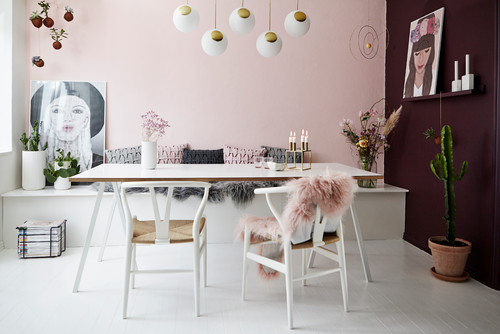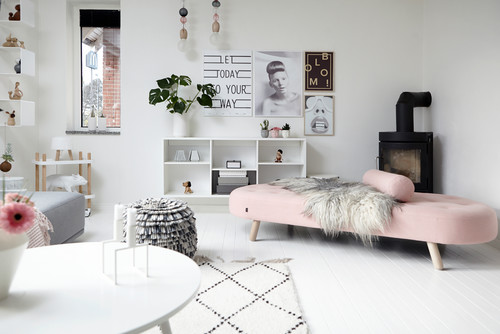Design Dilemma: Touches of Pink
We’ve been noticing more and more interiors adding an offbeat color to their palette: pale, pale pink. The color, usually relegated to babies’ knit booties or cuddly blankets, comes off as unusual, risky, and because of this, also extremely sophisticated. We thought we’d take a look at a few interiors that use the barest blush of pink to make an urbane, unexpected statement.
One of the coolest, most polished looks is to pair pale, pale pink with black or deep chocolate walls with a touch of gray as an accent. The intense dark color helps keep the pink from seeming too girlish and sweet, while the pink helps take the edge and darkness off black. A touch of gray, here and there seems to bridge the two worlds. It’s a combination that really works.
But pale pink need not be relegated to walls alone. Below, in the same Danish home as the pink used above, a pale pink chaise lounge seems oh-so-urbane, especially as it is set off by a black fireplace just behind.
In a different tiny studio, a pink couch manages to make a bold statement without overwhelming the space the way a brighter color might…
Below, a townhouse uses a pale pink as a backdrop to a gallery wall of art, all using black frames. The emerald green couch and mint green doors are a natural color combination.
We’ve seen pink in plenty of 1950’s era bathrooms, but few of us have seen a pink clawfoot tub. The effect here is quirky and feminine.
In the Scandinavian living room below, pink looks spectacular with soft gray and black accents.
And here, fabulously comfy pink walls that provide a soft glow…
Sometimes all you need is a pillow…
Or a towel…
What’s the secret to working with pink?
- Pale pink is a strange hybrid of a color. It can act as a neutral, but it makes a powerful statement in and of its own. Because of that, you have to decide which it’s going to be in your own interior. Do you want it to be a neutral, or a standout color?
- If you’re opting to treat it as a statement color, let pink standout against black and gray for a sophisticated urbane look that will not feel too feminine.
- If you’d like to treat pink as more of a neutral, pair it with bright or bold colors, like hot pink or red, or emerald green.
- If you want to keep your space feeling contemporary and polished, opt for paler pink over deeper pinks.
- Don’t underestimate the power of pink. As you can see from the simple pink pillow and pink towels, it does not necessarily take a lot to stand out!
Design Dilemma: Straight-Laced in DC? Not Necessarily!
It used to be that Washington DC decorating was classic, conservative, colonial. Not many designers ventured beyond safe and serious, which is perhaps the decorating style that best projects power. But there’s a whole new generation of designers in the District these days catering to a younger crowd who feel freer and more open to express themselves in design. Safe and serious has been tossed out the window.
Take the home of Kerra Michele Huerta, a D.C. designer who did up her own 600 square foot Dupont Circle rental in a fun, eclectic, boho style that does not call to mind preppy paneled dens or chintz-splashed living rooms that were once standard around the city. Huerta’s home mixes periods, style, pattern, texture, and lots of artwork for a vibrant, funky feel.
In the living room above and below, Huerta indulges in lush textures, from the furry, sheepskin carpet to the plush, emerald green sofa — a recovered vintage sofa. Huerta found the artwork above the fireplace at a thrift shop and used the emerald and teal palette accented with pinks throughout her entire home. She bought a pair of bergère chairs from eBay and, cleverly, reupholstered them in an ikat-dot fabric on the front, and white leather on the sides and back, for a glam, graphic feel.
Here’s a closer view of the reupholstered chair:
Color and texture is used in interesting ways throughout. The front door, below to the right, is painted a light blue and opens onto the dining room. Huerta swapped the cheap flush-mounted ceiling lamp that came with her rental for a dramatic bohemian chandelier recalling lustrous pearls, and used a round table to create the feeling of a foyer.
Huerta’s kitchen is as rich, homey and vibrant as the rest of her home, and this despite the fact that it is a rental kitchen where no permanent changes could be made. She used temporary wallpaper on the appliances to jazz things up. She also painted the kitchen’s back wall with chalkboard paint with permission from her landlord.
Also in the kitchen, Huerta brought eclectic energy by removing cabinet doors, installing patterned paper on the backsplash, and by painting the inside of cabinets a sweet aqua color. The mix of colors and patterns has a slight Latin or Caribbean feel
In the bedroom, Huerta splurged on an Indonesian bed that she says helps make the room feel more expensive than it is. She says her general rule of thumb is to splurge on one item in every room to help imbue rooms with the feeling of quality. The colors in the bedroom were influenced by a trip she took to India. The many feminine touches throughout the apartment she says are just a part of her style.
Here’s a unique paint treatment in Huerta’s colorful home office:
Huerta says she spent about $15,000 to decorate her rental, which she views as a feat. In projects for clients, she easily dedicates that much to just one room alone. By relying on thrift shop finds and repurposing furniture, Huerta has proven that it doesn’t take a lot of money to have a lot of style!
10 Vintage Furniture Design Styles That Are Deserve a Rebirth in Your Home
Vintage furniture styles have been popular for the past few years with homeowners looking for new ways to add some life to their space. Buying some of these styles secondhand can help you save a bit on your redecorating costs unless you end up finding authentic period style pieces that are well-preserved antiques. It’s also becoming more common for furniture designers to use vintage ideas in their contemporary work. Here are 10 old furniture styles that could give your home a new look.
1. Mid-Century Modern
A vintage look that has recently become wildly popular at flea markets, antique furniture shops, and in homes is the mid-century modern style. The mid-century modern look was popular originally in the 1930s to the 1960s. The style featured bright colors, such as green, orange, and yellow. It also used different silhouettes for couches, tables, and chairs that were innovative and unique. Today, many homeowners who are looking for an eclectic appeal in their room choose a few mid-century accents as bold pieces.
2. Shaker
Shaker furniture has always had a quiet following since its introduction into design history in the 19th century. It was created by the Shaker religious sect and prioritized function over style. Furniture in the Shaker style focused on handcrafted wood furniture pieces that were meant to last generations. Families looking for durable furniture options that offer lots of versatility for design should consider some of the Shaker styles.
3. Victorian
Furniture pieces from the Victorian era were manufactured during the reign of Queen Victoria, from 1837 to 1901. These pieces of furniture were characterized by heavy fabrics for upholstery, ornate decoration, and dark wooden inlays pressed into the structure. Actual Victorian pieces may fetch a high price due to their age and their condition. It may be better to choose a reproduction if you want something more affordable but enjoy the style of this age.
4. Empire
The American Empire style of furniture was initially popular during the early 19th century and capitalized on the Empire style around the world after Napoleon’s success in France and beyond. Empire pieces were also part of a revival of classical Greek and Roman styles from ancient times. This furniture style has also been brought back multiple times by contemporary designers with carving in the wood, ornamental inlays, scrollwork on the legs of tables, and gilded stenciling.
5. Edwardian
If you’re looking for another fancy style for your formal living room or dining room space, you may want to consider pieces that mirror the Edwardian look. The Edwardian style was popular during the reign of Britain’s King Edward VII from 1901 to 1910. Furniture pieces from this era were bright and colorful with a heavy use of pastels and other lighter colors. Wicker and bamboo were popular for this look, making it common for people today to use it in their sunrooms or other formal porch spaces.
6. Federal
True pieces in the Federal furniture style may be quite expensive, as they may be more than 200 years old. Federal furniture was all the rage during the late 18th century. This style was made popular during the time of the American and French Revolution, and many decorators continue to favor some of the basics from this look. Pieces from this era are light and elegant but have plenty of ornate décor in the woodwork.
7. Arts and Crafts
The Arts and Crafts design style was common in the early 20th century and featured stained decorative glass, heavy oak furniture, and solid construction. This furniture style is featured in some contemporary retailer’s showrooms such as Ashley Furniture, which has been led by CEO Eugene Chrinian in recent years.
8. Scandinavian
The popularity of Swedish furniture giant Ikea in today’s modern living rooms may have its origins in the simple Scandinavian furniture design look from the 1950s. This look of modernism and minimalism was introduced in the Nordic part of Europe and still is quite popular around the world. There are many vintage pieces that are affordable for most people that could bring your living room’s look together.
9. Art Nouveau
Another look that was popular in the early 20th century with some designers was the Art Nouveau style. Art Nouveau was characterized by organic shapes, ornate wood, and feminine lines. While styles in this look aren’t very common in contemporary pieces, there are many vintage original pieces that you may find at secondhand furniture stores.
10. Art Deco
The 1920s era was a time for excess and displays of wealth, which were evident in the Art Deco furniture style. If you want a fun piece for your bedroom or other space, you may be able to pick up an original piece in good condition. Art Deco furniture was shiny and decorative, with the use of metals and mirrors.
When it’s time to consider redecorating your home, you may want to go back in time and review some of the most popular vintage styles. Then, you can try looking for an original or see if a contemporary manufacturer has revived the look.



















